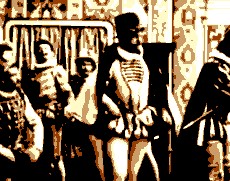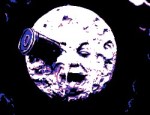Film Review
L'Assassinat du duc de Guise occupies an important place in the history
of cinema. Like Georges Méliès's
Le Voyage dans la lune
(1902), made six years earlier, its international success did much to galvanise
public interest in the new medium of cinema, but its main claim to fame is
that it is the first film to carry a complete dramatic narrative beyond one
reel. With a runtime of just over sixteen minutes, it relates a historical
incident - the assassination of the Duke de Guise in 1588 - but in addition
to this it presents the murder as a personal tragedy for a peripheral character,
de Guise's faithful mistress, the Marquise de Noirmoutiers. With its
combination of dramatic intrigue and character reaction to unfolding events,
the film lays the groundwork for the modern film drama.
There is some confusion over the film's title. On its opening caption,
it proclaims itself to be
La Mort du duc de Guise, but its film poster
refers to it by the title by which it is most widely known,
L'Assassinat
du duc de Guise. It was one of the first films made by the film
production company Le Film d'Art. The latter was founded by Paul Laffitte
in 1908, at the request of the Comédie-Française, with the
intention of making films with a historical or theatrical basis, thereby
raising the esteem of the new cinematographic art form. This was a
reaction to those (such as Méliès) who saw cinema as solely
a medium of mass entertainment. The remit of Le Film d'Art was primarily
educational and artistic. Despite its noble aims, the company rarely
turned a profit from its film creations,
L'Assassinat being the only
one that was an outright commercial success.
The film was scripted by the esteemed playwright Henri Lavedan, and directed
by André Calmettes and Charles Le Bargy, both prominent stage actors
of the time. Calmettes was artistic director for Film d'Art and Charles
Le Bargy - who also plays the part of Henri III in the film - was a leading
light of the Comédie-Française.
The cast comprises several members of the Comédie-Française,
notably Albert Lambert and Gabrielle Robinne, who play the doomed Duke and
his devoted mistress. Also appearing in the film, in minor roles, are
Albert Dieudonné and Jean Angelo, two actors who would come to prominence
in French cinema of the 1920s (the former best known for playing the lead
in Abel Gance's
Napoléon).
Although the staging and performances are unapologetically theatrical, the
actors avoid the excessive gestures that were employed more widely at the
time. Of particular note is Charles Le Bargy, who invests considerable
contained power and menace in his portrayal, creating an aura of scheming
nastiness through the subtlest of body and facial movements - a remarkably
modern film performance.
Whereas most films up until this time consisted of just one or two scenes,
with a single static shot for each scene,
L'Assassinat du duc de Guise
breaks its narrative up into five clearly delineated scenes and uses nine
shots. Interestingly, the one scene to employ more than one shot is
the one depicting the entrapment and brutal stabbing of the Duke de Guise.
By running over five shots, this sequence manages to create the illusion
of a dramatically shifting point of view without the camera actually moving.
In doing so, the tension is gradually ratcheted up, reaching a shocking climax
when the butchers finally strike and bring down their victim.
One of Calmettes's brainwaves was to have a specially commissioned musical
piece to accompany the film's projection (and hence mask the
noise of the spectators). This was supplied by Camille
Saint-Saëns. The film was screened for the first time at a cinema
salle in the rue Charras in Paris, on 17th November 1908, and met with a
rapturous reaction from its audience.
© James Travers 2002
The above content is owned by frenchfilms.org and must not be copied.
Film Synopsis
On 23rd December 1588 the long-running power-struggle between the opposing
houses of de Guise and Valois will come to a dramatic climax with the assassination
of Henri I of Lorraine, the Duke de Guise. The Duke's mistress, the
Marquise de Noirmoutier, is thrown into a state of disarray when she receives
a message imploring her to keep her lover with her. Unless she can
prevent the Duke from attending a meeting of the royal council, he will fall
into a trap laid by King Henri III of Navarre. Ignoring his mistress's
protestations, the Duke accepts the king's summons and sets out for the Château
de Blois without delay. On his arrival, he is surrounded by the king's
loyal bodyguards and brutally stabbed to death. The only person who
will mourn for him is the Marquise de Noirmoutiers...
© James Travers
The above content is owned by frenchfilms.org and must not be copied.



